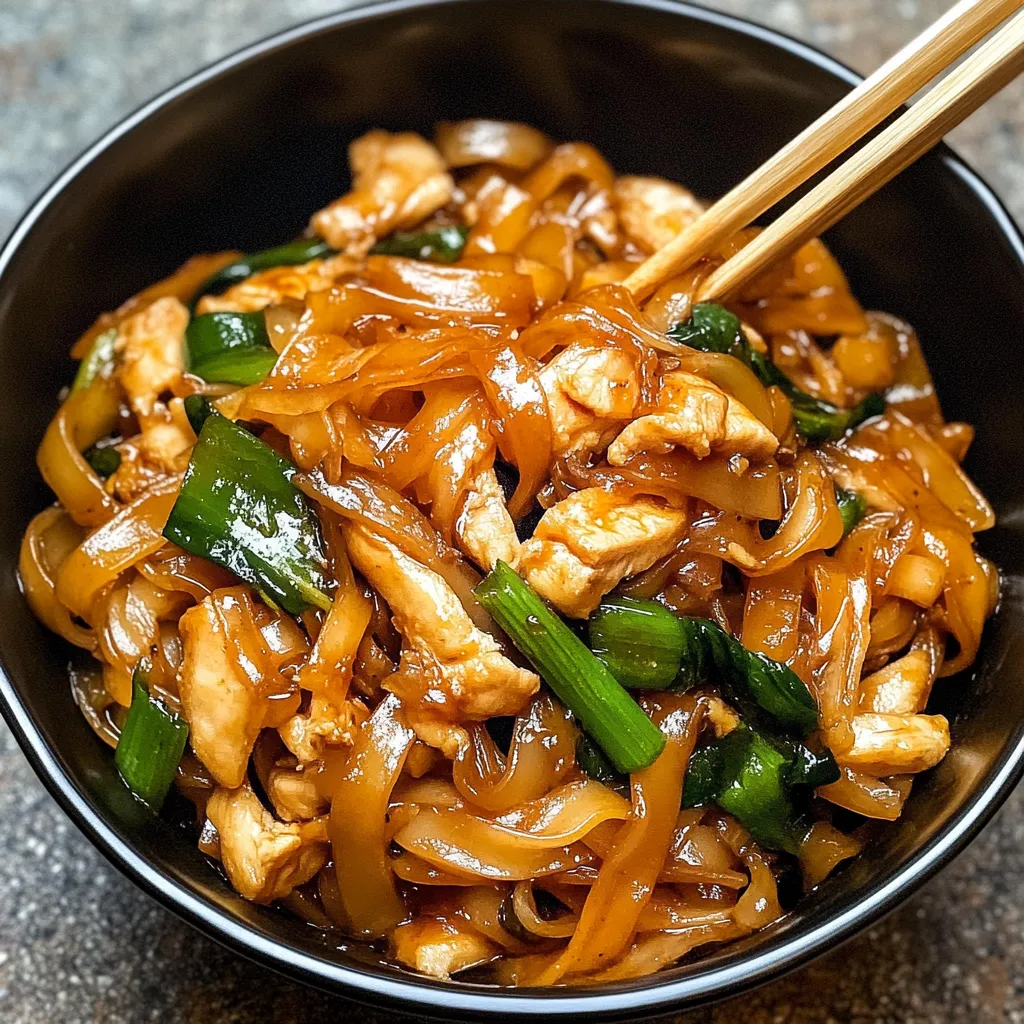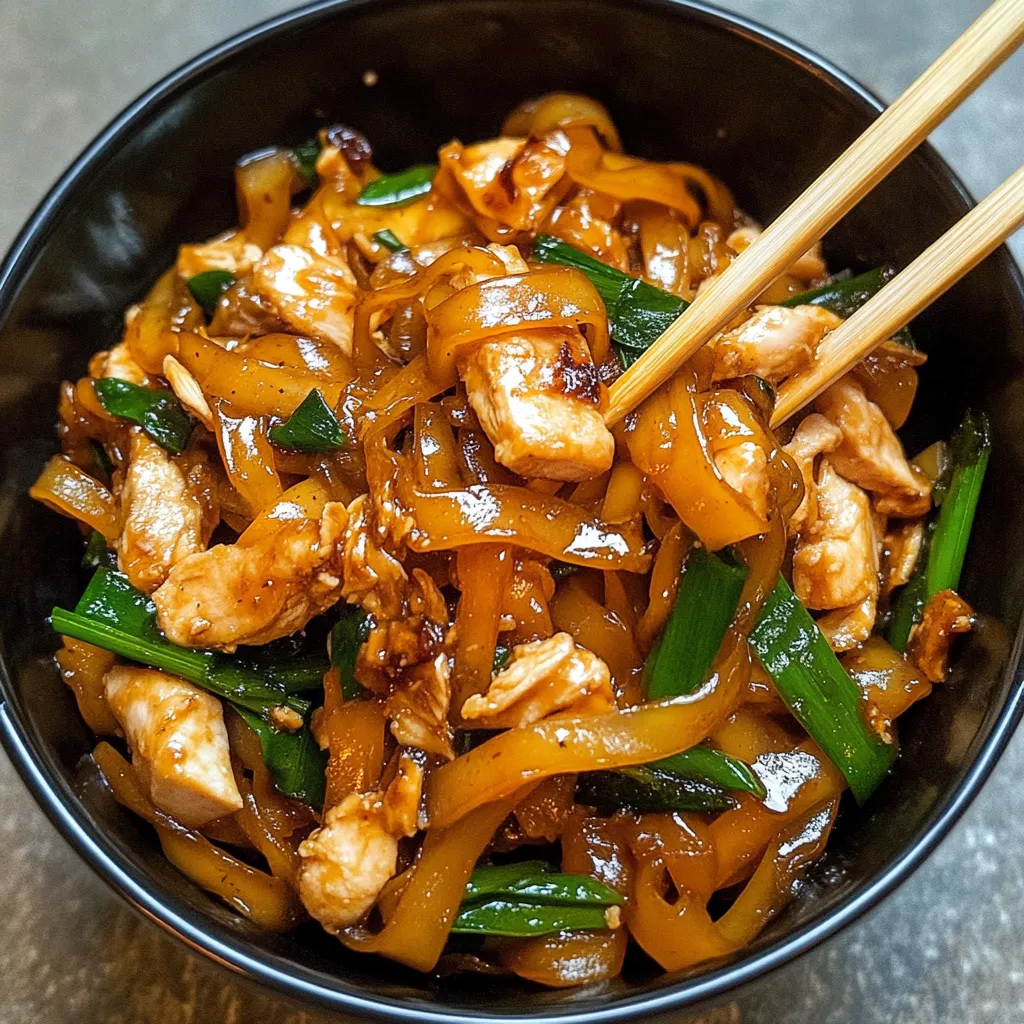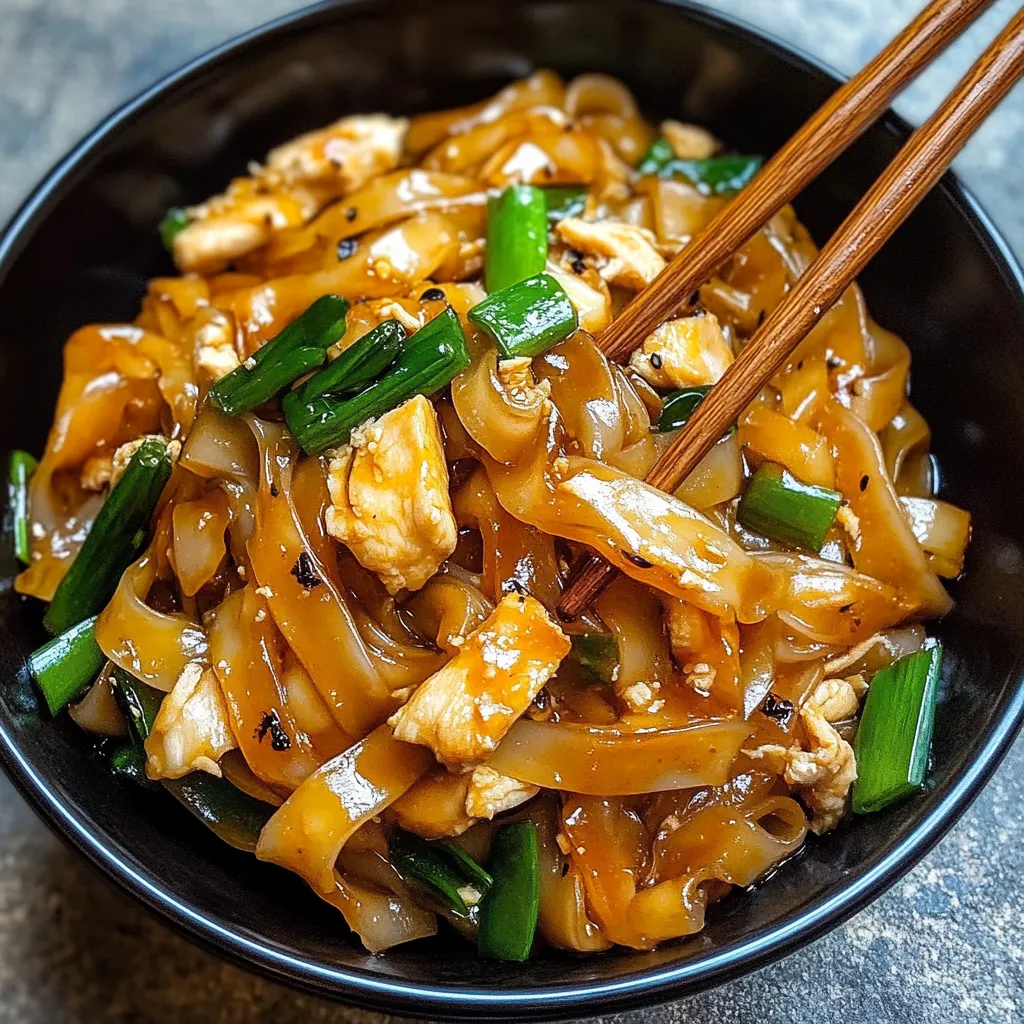 Save
Save
Thai drunken noodles deliver an intoxicating blend of spicy, savory, and slightly sweet flavors that transport you directly to the bustling street markets of Bangkok. These wide rice noodles, known as "pad kee mao" in Thai, get their distinctive character from the aromatic holy basil, fiery chilies, and umami-rich sauce that coats each strand. The dish comes together quickly in a blazing hot wok, where the ingredients dance and caramelize, creating those distinctive charred edges that street food enthusiasts crave. My first encounter with authentic drunken noodles happened during a backpacking trip through Thailand, where I watched in awe as a street vendor transformed simple ingredients into an unforgettable meal in mere minutes.
I made these noodles for my brother-in-law who lived in Thailand for three years. He took one bite, closed his eyes, and said it transported him straight back to his favorite street stall in Chiang Mai. That moment validated all the time I'd spent perfecting this recipe. What makes it special is the balance – the noodles aren't drowned in sauce but rather kissed with flavor, allowing the ingredients to shine individually while creating something greater together.
Flavorful Ingredients
- Wide Rice Noodles – Form the heart of the dish with their chewy texture and ability to soak up the flavorful sauce. Look for fresh noodles at Asian markets for the most authentic experience, or use dried ones soaked until just pliable but not soft.
- Thai Holy Basil – Provides the signature fragrant, slightly peppery flavor that defines drunken noodles. Regular basil works in a pinch, but the distinctive flavor of holy basil is worth seeking out.
- Bird's Eye Chilies – Deliver the characteristic heat that gives drunken noodles their reputation. These small, fiery chilies pack serious punch – adjust the quantity based on your heat tolerance.
- Dark Soy Sauce – Contributes rich color and deep flavor to the noodles. This thicker, slightly sweeter soy sauce creates the beautiful caramelized effect on the noodles.
- Oyster Sauce – Adds complex umami and subtle sweetness that balances the heat. Look for premium brands that list oysters as the first ingredient for the most authentic flavor.
- Fish Sauce – Provides that distinctive savory depth that defines Thai cooking. Just a small amount transforms the entire dish with its powerful umami properties.
- Fresh Garlic – Forms the aromatic foundation for authentic Thai flavors. Use the freshest garlic possible and chop it just before cooking for maximum impact.
Cooking Method
Prepare Perfect Noodles
Begin by properly preparing your rice noodles – this crucial first step determines the final texture of your dish. If using dried wide rice noodles, soak them in very warm (not boiling) water for approximately 20-30 minutes until they're pliable but still slightly firm in the center. Unlike Italian pasta, these noodles should not be boiled, as they'll continue cooking in the wok. Test a noodle by bending it – it should flex without breaking but retain some resistance. Once soaked, drain thoroughly and toss with a few drops of neutral oil to prevent sticking. This preparation ensures the noodles will absorb the sauce properly without becoming mushy or clumping together during stir-frying.
Create Flavor Base
Heat your wok until it's smoking – this extremely high heat is essential for authentic wok hei, the "breath of the wok" that gives stir-fried dishes their distinctive flavor. Add neutral vegetable oil and immediately introduce minced garlic and sliced bird's eye chilies. Work quickly, stirring constantly for about 10 seconds until intensely fragrant but not browned, which would create bitterness. Add sliced onions and bell peppers, tossing rapidly to maintain the high heat. The vegetables should begin to soften slightly while retaining some crispness and taking on a slight char at the edges. This quick cooking preserves their texture and fresh flavor while developing complexity through caramelization.
Perfect Protein Integration
Add your protein of choice – traditionally thinly sliced chicken breast – to the screaming hot wok. Spread it out to maximize contact with the hot surface, allowing it to sear for 15-20 seconds before stirring. This creates delicious caramelization and prevents the meat from stewing in its own juices. Stir-fry rapidly until the chicken is just cooked through but still tender, about 2-3 minutes total. The high heat seals in juices while creating those desirable browned edges that contribute significant flavor. The protein should finish cooking just as it begins to take on color but before it becomes tough.
Noodle Magic
Now comes the dramatic moment – add the prepared rice noodles to the wok and immediately toss with all the ingredients. With confident movements, pour the sauce mixture (soy sauce, dark soy sauce, oyster sauce, fish sauce, and a touch of sugar) around the sides of the wok rather than directly onto the noodles. This allows the sauce to heat instantly against the hot wok surface, caramelizing slightly before coating the noodles. Keep everything moving constantly, lifting from the bottom and folding over, allowing the noodles to pick up the smoky wok flavor. After about two minutes, when the noodles have absorbed most of the sauce and begun to take on a beautiful caramelized color, toss in the fresh Thai basil leaves. Give everything one final toss just until the basil wilts, releasing its aromatic oils into the dish.
 Save
Save
I learned the importance of extreme heat when cooking this dish after a disappointing first attempt where my noodles turned out pale and soggy. Later, I watched a Thai chef make the same dish in a wok that was literally smoking, producing beautifully charred, flavorful noodles in minutes. The difference was dramatic. My family now knows to expect a bit of smoke when I'm making drunken noodles – they joke that the smoke detector is our "dinner bell" for Thai night. My daughter, initially skeptical of spicy food, has gradually increased her tolerance and now requests "just a little bit of chili" in her portion, which I count as a culinary parenting victory.
Perfect Pairings
This bold dish stands beautifully on its own but welcomes complementary sides and beverages. Serve alongside a cool cucumber salad dressed simply with rice vinegar and a touch of sugar to provide refreshing contrast to the spicy noodles. Thai iced tea, with its creamy sweetness, helps tame the heat while complementing the aromatic herbs in the dish.
For a more elaborate meal, pair with crispy spring rolls and a light broth soup to start. The contrasting textures and temperatures create a balanced dining experience. When entertaining, I arrange the noodles on a large platter garnished with extra basil leaves, lime wedges, and sliced chilies, allowing guests to customize their heat level and acidity to taste.
Tasty Twists
Seafood Sensation
Transform this dish by substituting the chicken with a combination of plump shrimp and tender squid rings. These seafood proteins cook even more quickly than chicken, requiring just 60-90 seconds in the hot wok until just opaque. The natural sweetness of seafood creates beautiful harmony with the spicy, aromatic sauce. Finish with an extra squeeze of lime to brighten the oceanic flavors.
Vegetarian Delight
Create a plant-based version by replacing the chicken with pressed, extra-firm tofu cut into bite-sized cubes. For best results, press the tofu between paper towels weighted with a heavy skillet for 30 minutes before cooking to remove excess moisture. This allows the tofu to develop a satisfying golden crust in the hot wok. Add extra vegetables like baby corn, water chestnuts, or snap peas for additional texture and nutrition. Substitute vegetarian mushroom sauce for the oyster and fish sauces to maintain that crucial umami depth.
Northern Thai Variation
Adapt this recipe with northern Thai influences by adding a tablespoon of fermented soybean paste (thua nao) to the sauce mixture. Incorporate sliced green beans and cherry tomatoes into the stir-fry, and finish with a handful of fresh dill instead of basil for an unexpected but authentic regional twist. This variation offers a fascinating glimpse into the diversity of Thai cuisine beyond the more familiar central Thai dishes.
Storing Leftovers
Cooling Technique
Allow any leftovers to cool completely before refrigerating, but don't leave them at room temperature for more than one hour. Spread the noodles out somewhat in a shallow container rather than packing them tightly, which helps them cool faster and prevents them from becoming overly soft from trapped steam.
Revitalizing Methods
When reheating, add a small splash of water to the noodles and heat them in a hot wok or skillet rather than the microwave. The high heat reactivates the flavors and helps restore some of the original texture. Add a few fresh basil leaves and a squeeze of lime just before serving to brighten the reheated dish.
Freshness Duration
These noodles are best enjoyed immediately after cooking, but they can be stored in an airtight container in the refrigerator for up to two days. The flavors actually continue to develop overnight, sometimes making next-day noodles even more flavorful, though the texture of the noodles will soften somewhat.
 Save
Save
I've come to treasure this drunken noodles recipe not just for its incredible flavor but for how it connects me to memories of traveling through Thailand. There's something magical about recreating street food in your own kitchen – the familiar aromas that fill the house, the satisfaction of mastering wok cooking techniques, and the joy of sharing authentic flavors with friends and family who may never have experienced them otherwise. What began as an attempt to recapture vacation memories has become a beloved tradition in our home, appearing regularly on our dinner table whenever we crave something bold, comforting, and just a little bit dangerous in its spicy intensity.
Common Questions About Cooking
- → Why is it called 'Drunken Noodles' if there's no alcohol?
- Despite the name, there's no alcohol in this dish! It's called 'Drunken Noodles' (or Pad Kee Mao in Thai) because it's traditionally eaten after a night of drinking to help with hangovers, or because the spiciness makes you feel drunk.
- → Can I make this dish less spicy?
- Absolutely! Simply reduce the amount of Thai bird chilies or omit them completely. The dish will still be flavorful thanks to the garlic, basil, and sauce combination, just without the heat.
- → What's the difference between Thai basil and regular basil?
- Thai basil has purple stems and a more licorice or anise-like flavor compared to Italian sweet basil. If you can't find Thai basil, regular basil will work, though the flavor profile will be slightly different.
- → Can I make this dish ahead of time?
- This dish is best enjoyed fresh, as rice noodles tend to absorb sauce and become softer over time. If you need to prepare ahead, I'd recommend cooking everything except the noodles, then adding freshly cooked noodles when ready to serve.
- → What can I substitute for fish sauce?
- For a vegetarian version, you can use soy sauce with a splash of lime juice, or look for vegetarian 'fish sauce' made from seaweed. The flavor won't be exactly the same, but it will still be delicious.
